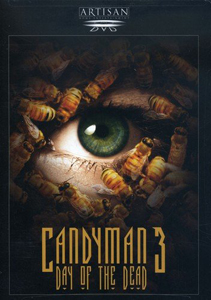Slasher sequels have a reputation for being unoriginal, but “Candyman: Day of the Dead” (1999) is a particularly blatant case. Coming out even after the “Scream” saga made fun of sequels, it repeats the same plot as the first two films, moving the action to Los Angeles and chronicling the little girl introduced at the end of “Farewell to the Flesh.”
Can’t use ignorance as excuse
Candyman’s (Tony Todd) last surviving descendant, Caroline (Donna D’Errico, “Baywatch”), is now an adult. So this entry takes place several years into the 21st century. Like the “Friday the 13th” sequels, we’re not supposed to think too hard about the time jump. It plays OK here; a cellphone is outdated, but otherwise it’s plausible.
As with part two, the straight-to-video “Day of the Dead” will play better if it’s your first “Candyman” film. It repeats the origin story (and for some reason shoots new footage of Candyman’s murder). It’s somehow newer to Caroline than it is to a returning viewer.

From Aug. 25-27, we’re looking back at the first three “Candyman” films, leading up to the release of the fourth entry.

“Candyman: Day of the Dead” (1999)
Director: Turi Meyer
Writers: Alfredo Septien, Turi Meyer (screenplay); Clive Barker (characters)
Stars: Donna D’Errico, Tony Todd, Jsu Garcia
This is despite the fact that Caroline was named by her late mother Annie (Elizabeth Hayes, replacing Kelly Rowan) for Candyman’s beloved. As we know from “Farewell,” Annie taught her daughter about their ancestry. It’s always dumb when someone speaks Candyman’s name five times into a mirror, but Caroline in particular can’t claim ignorance.
D’Errico goes through the events looking suitably scared. As a potential love interest David, Jsu Garcia has charisma. And as corrupt cop Kraft, Wade Williams drips the slime that would earn him similar roles on “Prison Break” and beyond.
We’ve been down this path before
The screenplay by Turi Meyer (who also directs) and Alfredo Septien only gives the actors clichés and repeated arcs to work with. “Day of the Dead” continues the tradition of exploring an oppressed group; this time it’s Los Angelino Hispanics.
The settings are often well-selected, including a strikingly graffiti-covered subway tunnel. But Candyman is more ingrained in the Chicago and New Orleans myths of the previous films. Here, he’s mainly concerned with Caroline, until a mild twist in the final act involving gang members who stupidly begin to worship him.
As Candyman repeats his familiar goal of framing someone for murders to try to get them to submit to him, Meyer tries to spice things up with style. Yet there’s no sense of mood.

“Day of the Dead” includes lots of images of bees and dripping blood. Sometimes it’s in reality, sometimes in Caroline’s nightmares. Candyman’s killings, although gory in rote fashion, are not shocking. Even attempts at basic jump scares misfire.
Although there are mild, random (and unearned) new additions to the mythology in “Candyman: Day of the Dead” – centering on Candyman’s paintings – my overwhelming impression is that I have watched this movie twice before. And it was better the previous two times.

